How Weather Affects Fishing: All You Need To Know
We’ve all been there. You get ready for a perfect day of fishing, pick your best lures and your favorite rod, only to sit out on the boat watching your line idle without a single bite. “What did I do wrong?” you ask yourself. A painful question pretty much every single angler has asked at some point. Well, we’ve got some good news and bad news for you: It wasn’t really your fault. But in a way, it was. Why did you strike out? The answer, more often than not, lies in how the weather affects fishing. And today, you’re going to learn all there is to know about it.
To understand exactly how the weather affects fish, we’ll first take a look at the individual weather factors that influence the way fish behave. We’ll then explore how these factors make fish tick (or tock). Last but not least, we’ll talk about the best weather conditions for fishing, as well as what you can do to make the most out of your outing.
By the time you’ve read this article, you’ll not only have a few geeky facts to tell your friends, you’ll also know some tricks to help you round the day off with a full cooler.
The weather can affect fishing in a number of ways. A few naturally-occurring elements are key influencers on the way fish behave. These are:
- Water temperature
- Wind
- Barometric pressure
Water Temperature
Most fish species are cold-blooded, and can’t regulate their body temperature. This means that they’re forced to adjust their metabolisms to the temperature of the water around them. In colder waters, fish tend to slow down, and generally need less food to support themselves. In warmer waters, they are much more active, and as a result, need significantly more food to survive.
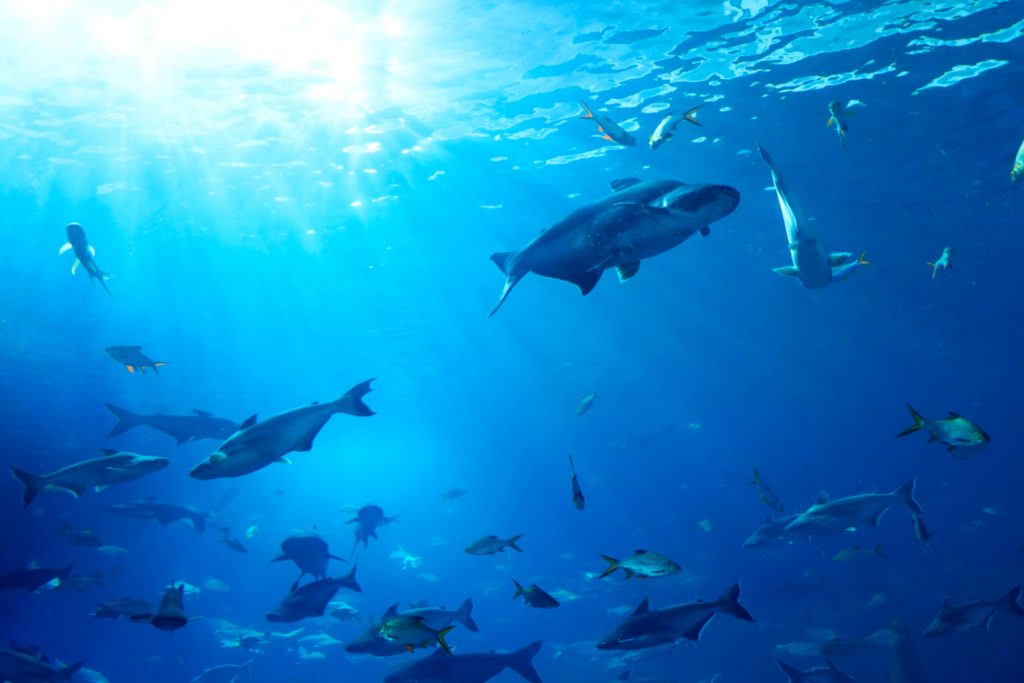
But that’s not the only way water temperatures affect fish. In order to breathe, fish rely on their gills to extract dissolved oxygen from the water. It so happens that the amount of dissolved oxygen in the water depends almost exclusively on the surrounding temperature. As a rule of thumb, colder waters have more dissolved oxygen, and warmer waters have less.
So, what’s the big deal? Simply put, each fish species has a minimum water temperature under which it won’t feed, and a maximum water temperature over which it can’t breathe. As a fisherman, you obviously don’t need to know the exact numbers. However, knowing why and when water temperatures change can make all the difference when trying to catch fish.
How does the weather influence water temperatures?
Water temperature can change in a number of ways. There are slow, seasonal changes, which are mainly influenced by the amount of sunlight a body of water receives over an extended period of time. These changes don’t have a tremendous impact on water temperature in the short term.
Even if you’re fishing a small pond, a passing cloud won’t realistically change the temperature by a significant amount. What can drastically change the water temperature, however, is rainfall.
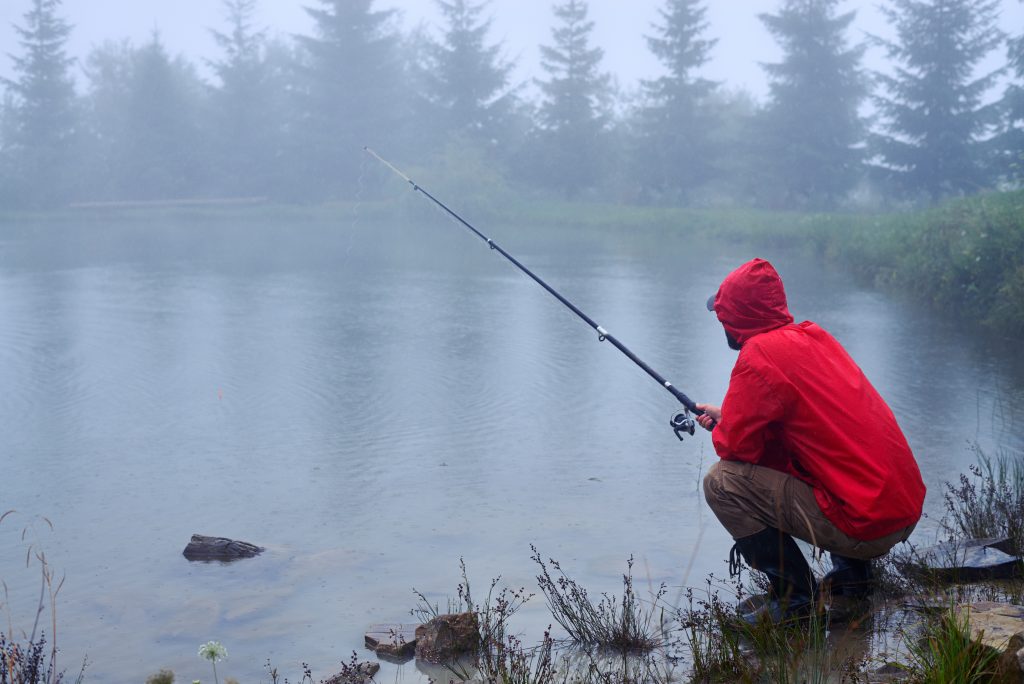
When it rains, fresh water pours into a body of water, changing its temperature. This change can happen quickly, especially if we’re talking about a small body of water. In addition, rainfall changes the turbidity (clarity) of the water, as well as the salinity of saltwater. Lastly, rain can often shoot large quantities of nutrients into the water. When all these changes occur at the same time, they can significantly change the way resident fish behave.
Wind
In North America, winds generally blow in a northeast direction. This happens for two reasons: first, the Earth’s rotation, and second, the jet stream. During the summer, the jet stream shifts to the north, pulling warm gusts of low-pressure air from the southwest with it. This is why we have those warm summer winds. During fall and winter, the jet stream shifts to the south, bringing cold fronts and high-pressure air masses from the north.
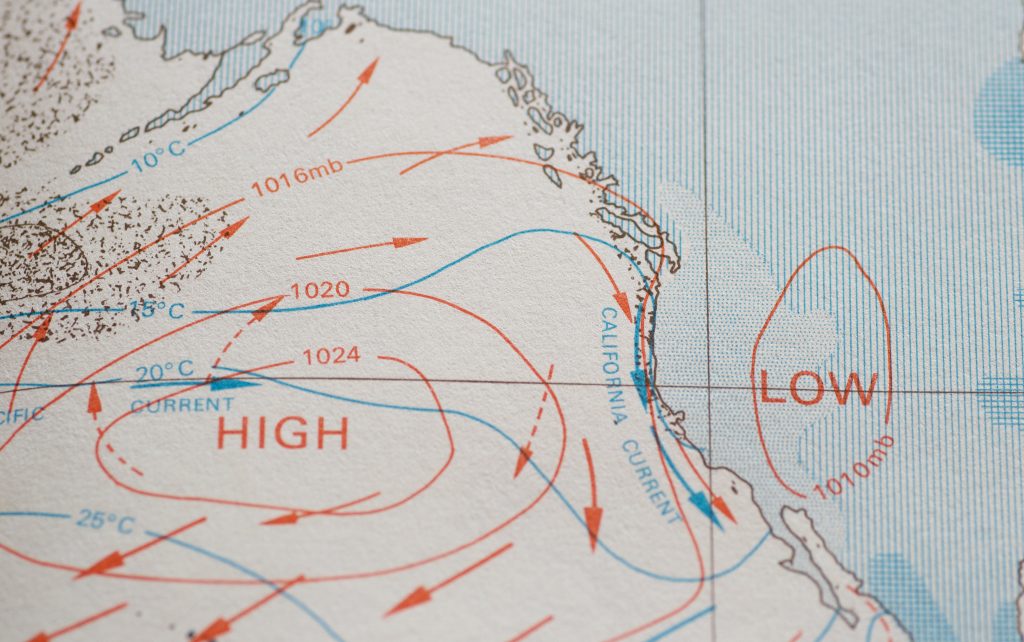
When masses of cold and warm air mix, storms start to brew. But more on this in a bit.
Winds can influence water bodies and their residents in several ways. The most obvious one, of course, is by making waves. As winds blows along the surface of the water, it creates friction. The stronger the wind blows, the greater the friction, and the greater the waves.
Waves can increase the turbidity of the water, pulling currents and nutrients along with them. All of these factors influence the way fish will behave. Last but not least, winds cause changes in barometric pressure.
Barometric Pressure
If there’s one thing that can bring about a feeding frenzy in fish, it’s a change in barometric pressure. Sudden weather changes produce rapid shifts in barometric pressure, and this is precisely why these are the best moments to wet your line.
What is barometric pressure?
Barometric pressure, or atmospheric pressure, is the force exerted by the Earth’s atmosphere on a given area. Think of it as “the weight of the air.” Barometric pressure is measured in several ways: inches of mercury (in-Hg), millibars (mb), or pounds per square inch (psi). In the US, we mostly use inches Hg. At sea level, barometric pressure of 29.92 inches is “normal.” Anything above that is considered high, and anything below that, low.
Again, you don’t need to focus on absolute numbers, because fish aren’t paying much attention either. What you should make note of is that just as the atmosphere pushes down on Earth’s surface, it does the same to its many bodies of water. These waters, in turn, push on the fish that live there.
Why does barometric pressure affect fish?
To survive in water, fish had to develop a series of physical adaptations. When it comes barometric pressure and fish behavior, two of these adaptations are key. These are the lateral line and the swim bladder.
The lateral line is an organ fish use to navigate and sense the presence of predators or food. It senses the tiniest of reverberations in the water, and as such, it is very sensitive to pressure changes.
The swim bladder, on the other hand, is an organ similar to the stomach, which can inflate with air and allows the fish to achieve buoyancy. As the air pressure changes, so does the pressure on a fish’s swim bladder. It’s something like a natural barometer.
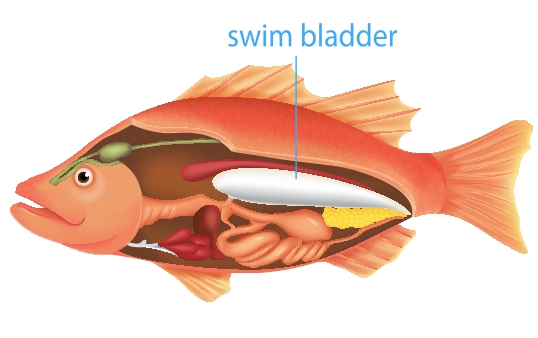
Fish species like Trout, Grouper, Snapper, and Tarpon have larger swim bladders, and are more sensitive to changes in air pressure. On the other hand, species with smaller bladders like Mahi Mahi, Barracuda, Wahoo, and Kingfish are much less affected. And then there are species like Sharks and various types of Tuna that don’t have this organ at all.
Barometric Pressure and Fishing
Alright, air pressure affects fish, we understand. But exactly when and how does this happen? It’s a well-known fact that rising barometric pressure means improving weather and clear skies. Conversely, dropping barometric pressure means that a storm or a cold front is on its way.
Fishing before and after a Storm
As a storm approaches, a mass of warm, low-pressure air gathers above a mass of cold, high-pressure air. When the two air masses meet, they start creating condensation in the form of clouds. During this time, a noticeable, steady drop in air pressure occurs. The pressure continues to drop until the very end of the storm.
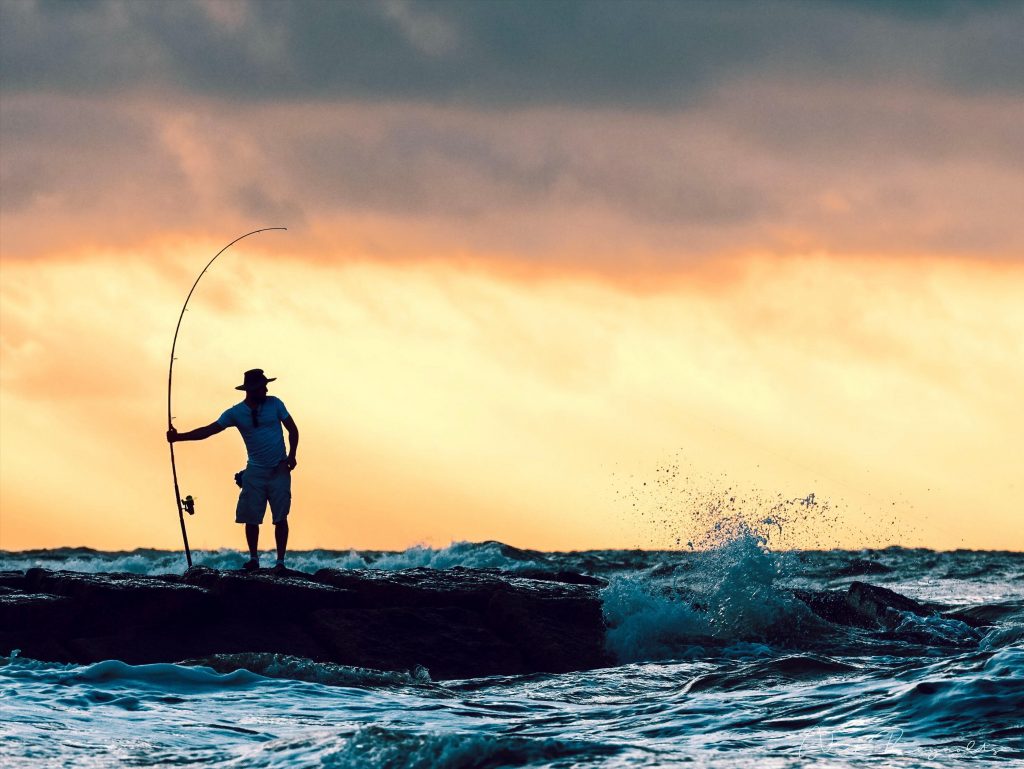
Depending on the scale of the storm, this can happen very quickly, or over an extended period of time. For you, the latter is a much better option, as it gives you more time to fish while the pressure is dropping.
What follows the storm is typically a cold front, bringing winds, and a mass of cold, high-pressure air. The cold front often clears the skies, and more importantly, brings about a rapid rise in air pressure. In most cases, this means that fishing is a no-go.
Once the air pressure reaches a high point, it finally stabilizes. There’s no set rule on how long this can take, as it usually depends on the storm that just passed. Fish are mostly inactive after the atmospheric pressure levels out. However, around 72 hours into this period of steady barometric pressure, the fish start coming out again.
Interestingly, fish seem to be much keener on biting than before the weather change started. Some anglers speculate that this is because there was no fishing for several days, and fish have “forgotten” about the hooks and lures they normally avoid. A more realistic cause for the increased bite, however, seems to be that the fish haven’t fed in a while.
Fishing Tactics for Changing Weather
All of the weather factors we mentioned are very closely connected, meaning that one doesn’t change without the other. To make the perfect fishing tactic, you’re going to need to be mindful of them all.
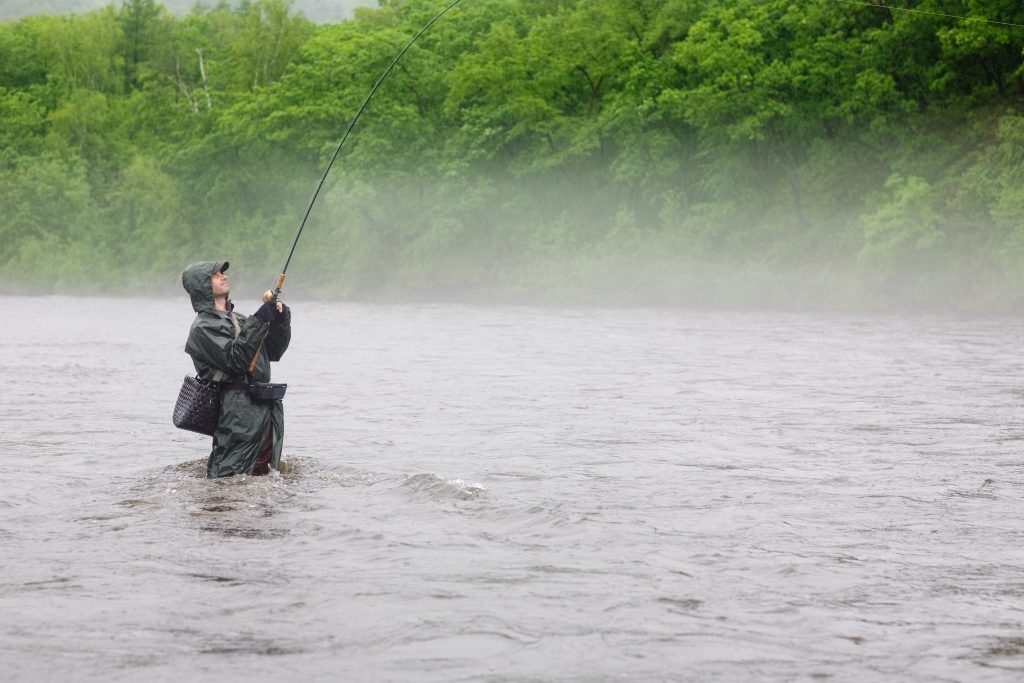
Timing
Summarizing what we talked about above, fish react to changes in barometric pressure in the following way:
- Rapid drops in pressure: changes of more than 0.18 inches Hg in 3 hours, the bite is great
- Rapid rise in pressure: the fish retreat, the bite is non-existent
- Stable pressure: after 3 days of pressure not changing by more than 0.3 inches Hg, the bite is good again
Nowadays, there are plenty of barometer-equipped fishing apps which you can use to track and plan your outings.
Temperature and Turbidity
In colder weather, fish are sluggish, so your lure/bait presentation should be slow-moving as well. Of course, the contrary is true for warmer conditions.
As we mentioned, wind and rainfall can make waters more turbid than normal. Turbidity can drastically limit visibility underwater, and in turn, change the way fish behave. For the most part, fish are sight hunters. When they can’t see, they’ll rely more on their lateral line to find prey. This is where fast action lures can come in handy. The flutter these lures make is the perfect attention-grabber in such situations.
Still, if you’re fishing cold waters, the fish might not be as easily lured to move (no pun intended). In these situations, you’ll need to rely on brightly colored lures to get them to bite. Reds, yellows, and greens can all produce results. In muddy waters, however, red-colored lures tend to lose their visibility. If this is the case, your best bet is to stick to bright yellow and green presentations.
If the seas are rough, chances are that fish have retreated to deeper waters. If you’re determined to fish in these conditions, make sure you’ve chosen the right kind of boat.
Enjoy Responsibly
Fishing ahead of an upcoming storm can produce incredible results. There are countless stories of fishermen cashing in on the feeding frenzy while other anglers are stuck on the highway trying to get home.
Still, as much as it would be cool to be the star of “Twister 2.0,” no fish is worth losing your head over. Read the weather and fishing reports carefully, and give yourself a time cushion to leave the area in case you get held up.
Get things right, however, and you could be looking at catching the fish of lifetime! So there you have it. That covers everything you need to know about how weather affects fishing.
This essay is from: https://fishingbooker.com/blog/how-weather-affects-fishing/



























